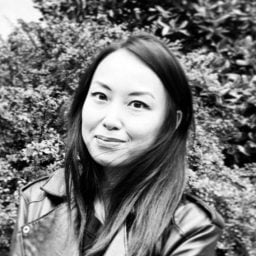Art & Exhibitions
Robert Rauschenberg’s Radical Project to Bring Together Artists and Engineers Gets the Getty Spotlight
Rauschenberg and Robert Whitman launched E.A.T. alongside Bell Labs engineers Billy Klüver and Fred Waldhauer.
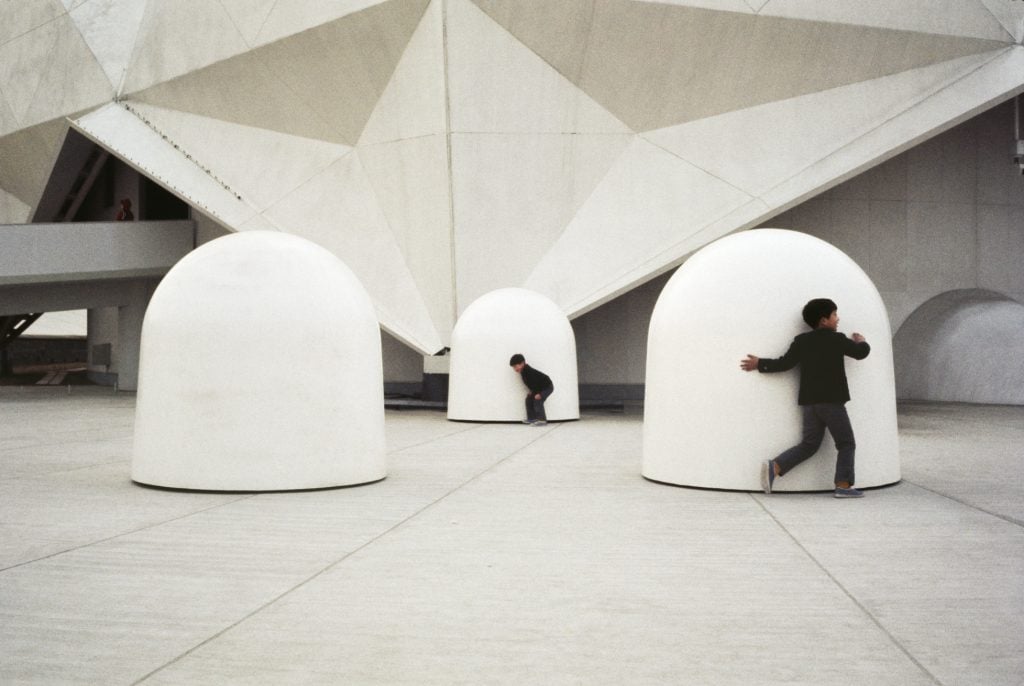
One fall evening in 1966, an audience crowded the 69th Regiment Armory in New York for a curious art happening titled “9 Evenings: Theatre & Engineering.”
Over the course of the night, a series of performances unfolded. Visitors watched Yvonne Rainer direct a group of participants via walkie-talkie to move large objects around a stage; they saw John Cage orchestrate a choir of telephones and radios; and they observed as Frank Stella played tennis with Mimi Kanarek using rackets wired with transmitters. They wound their way through a billowy maze Steve Paxton created with polyethylene sheets. More than 10,000 people attended the 10-day run; critics savaged it.
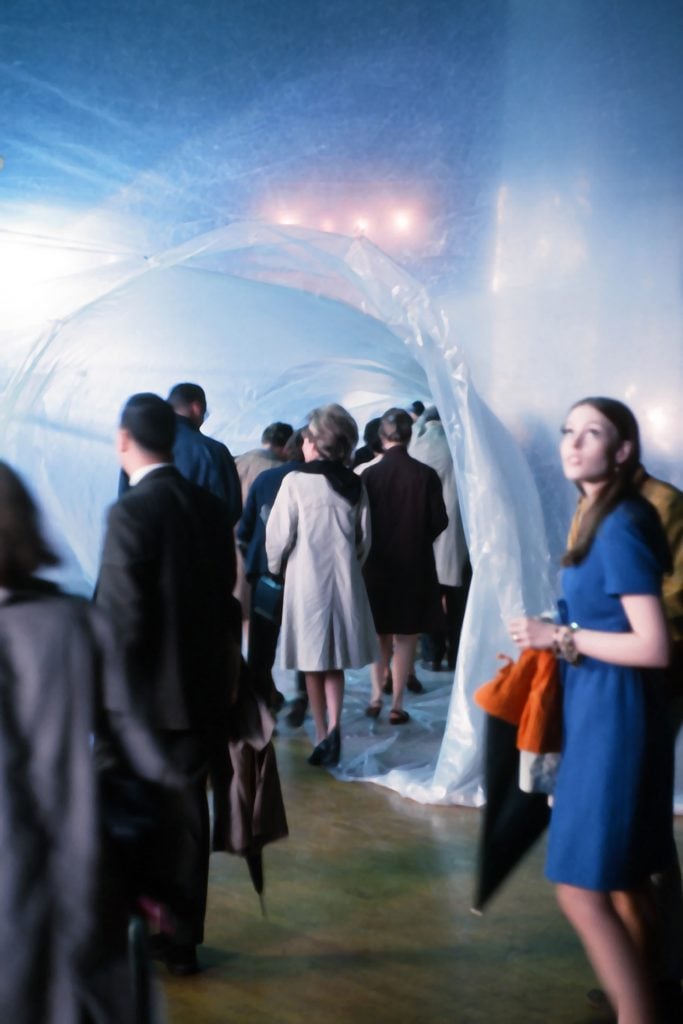
Audience members walk through Steve Paxton’s Physical Things at “9 Evenings: Theatre & Engineering” at the 69th Regiment Armory in New York, 1966. Photo: Robert R. McElroy / Getty Images.
The event was staged by 10 artists in collaboration with 30 engineers from Bell Labs, intended to showcase the possibilities of marrying their skills. As planning committee member Simone Forti reflected, it was less an art presentation than “a step towards the creation of a situation that will later be important to the making of art.” It’s a prescient observation, as “9 Evenings” would come to serve as a proof-of-concept for the initiative behind it, one that sought to inject technology into art-making.
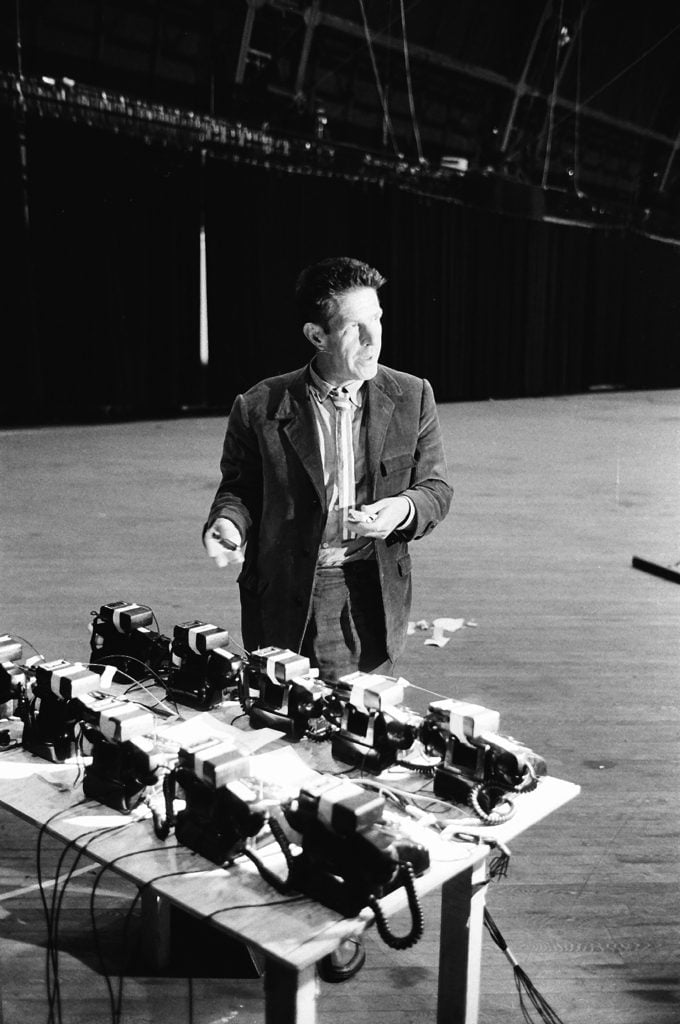
John Cage sets up telephones for Variations VII at “9 Evenings: Theatre & Engineering” at the 69th Regiment Armory in New York, 1966. Photo: Robert R. McElroy / Getty Images.
Experiments in Art and Technology (E.A.T.) was in nascent form when “9 Evenings” took place—a cross-disciplinary concept sketched out by artists Robert Rauschenberg and Robert Whitman in collaboration with Bell Labs engineers Billy Klüver and Fred Waldhauer. Its New York debut spurred its cementing into an organization with the goal of helping artists “achiev[e] new art through new technology,” as Rauschenberg and Klüver wrote in the first E.A.T. newsletter. The group was soon inundated with dozens upon dozens of requests from creatives eager to expand their practices.
“E.A.T. was a phenomenon,” curator Nancy Perloff told me. “Unlike today, it was a resource with a capital R that would allow artists to experiment.”
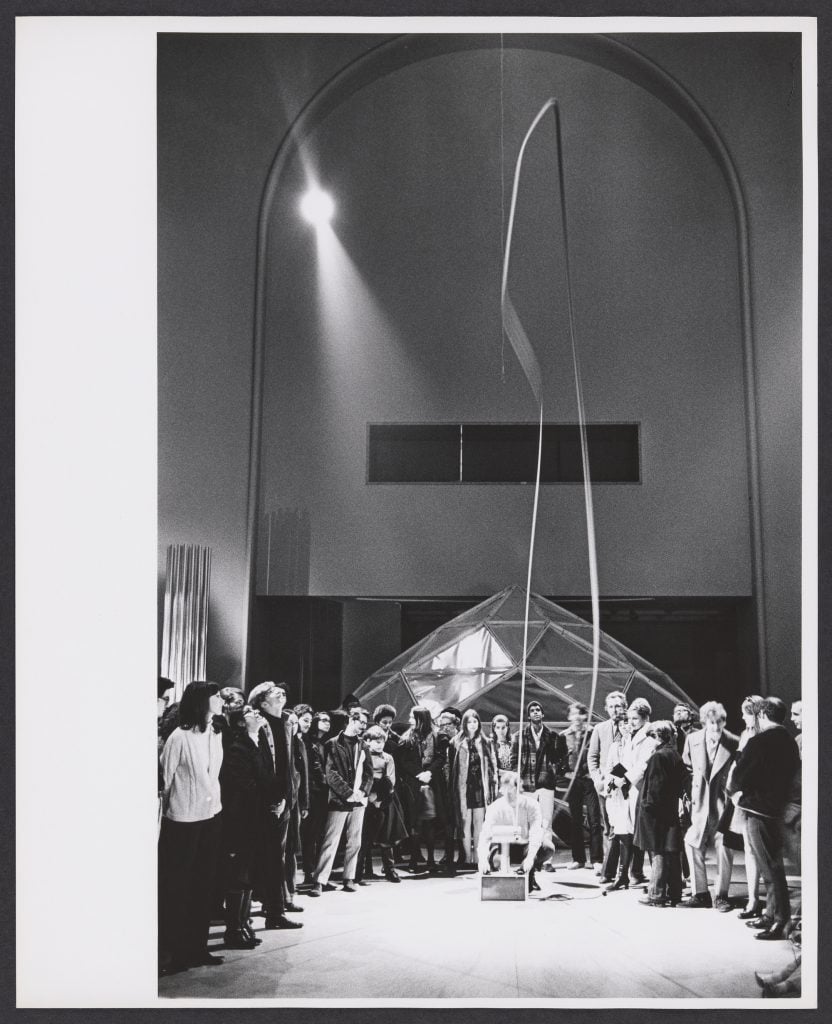
Lucy Jackson Young and Niels O. Young, Fakir in 3⁄4 Time (1968). Photo: Shunk-Kender. Art courtesy Thomas Young. © J. Paul Getty Trust.
Perloff is one of the masterminds behind “Sensing the Future,” an exhibition at Los Angeles’ Getty Research Institute that revisits E.A.T.’s brief yet meaningful existence. The show, part of PST Art, unfolds across two galleries, with artifacts surfaced from the institute’s archives.
The organization’s early days fill the first room. Detailed here are its founding members’ early art-tech experiments (Rauschenberg’s Dry Cell, for example), as well as E.A.T.’s 1967 collaboration with New York’s Museum of Modern Art on an open call for artworks created with technology (nine works from which were included in the 1968 show, “The Machine as Seen at the End of the Mechanical Age“).
“9 Evenings,” of course, takes up the bulk of the space, its happenings presented in the form of archival photos, videos, and documents. Just as intriguing are the letters that E.A.T. received after the event; blown up and arrayed on a wall, they were sent in by the likes of Hans Haacke, Eva Hesse, Marta Minujín, and David Hinton, all seeking to work with the group. Hesse, for one, was super keen on “chemistry.”
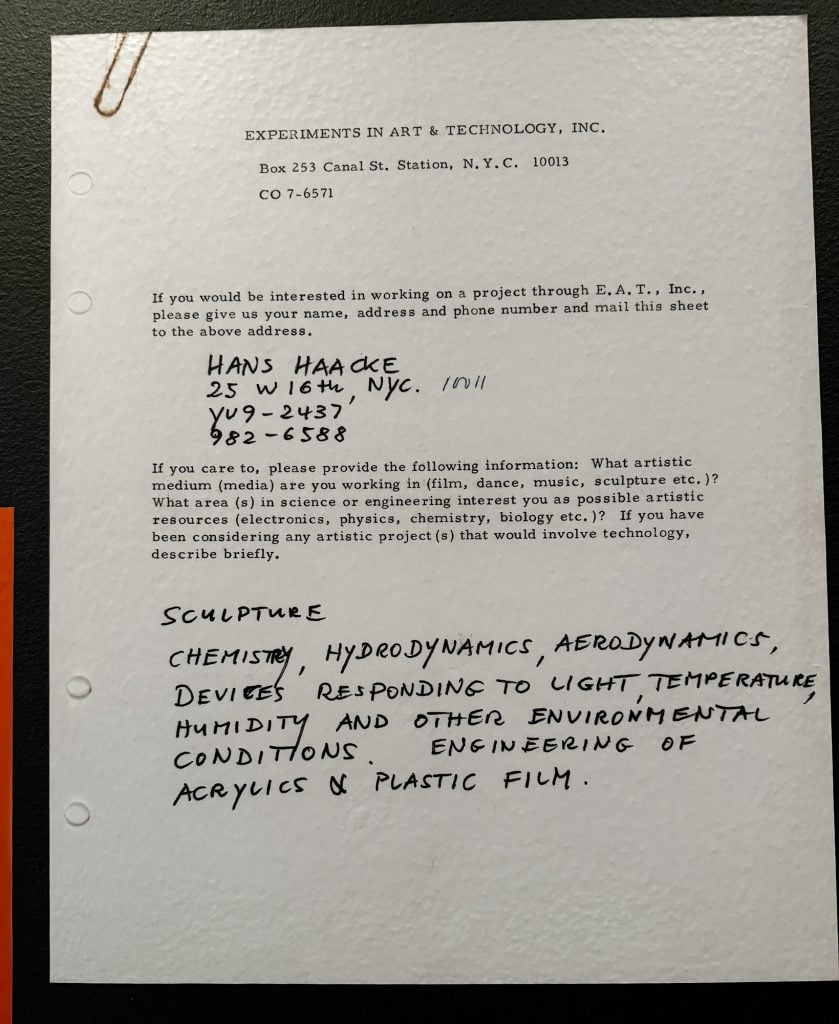
A letter from Hans Haacke, on view at “Sensing the Future: Experiments in Art and Technology (E.A.T.)” at the Getty Research Institute. Photo: Min Chen.
“They are a tiny, tiny fraction of what’s in the archive,” said Perloff of these submissions to E.A.T.’s Technical Services division. “The archive has these punch cards, where artists would put down the materials they wanted, and the engineer would then look at that and respond. The requests came from visual artists, composers, poets—E.A.T. was very cross-disciplinary, all the time.”
That was most evident in E.A.T.’s pièce de résistance: its design for the Pepsi Pavilion at the 1970 Japan World Exposition. The project called on the expertise of 75 artists, architects, and engineers, not counting the labor of American and Japanese construction companies.
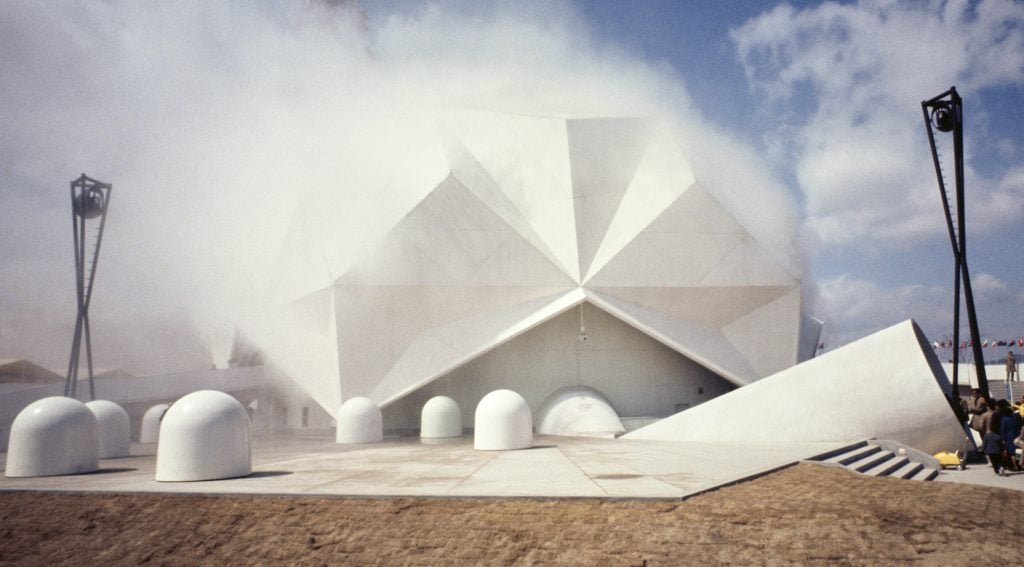
Pepsi-Cola Pavilion, 1970. Photo: Shunk-Kender. Floats © Robert Breer/Kate Flax/gb agency, Paris. Fog © Fujiko Nakaya. Courtesy Experiments in Art and Technology. Light Towers © Forrest Myers. © J. Paul Getty Trust.
Once unveiled, the pavilion took the shape of a geodesic dome. To reach it, visitors navigated a cloud of fog sculpted by Japanese artist Fujiko Nakaya before encountering kinetic dome-shaped robots designed by sculptor Robert Breer and engineer John Ryde.
The pavilion’s interior was far more dramatic: its spherical ceiling was an aluminized mylar mirror, a mammoth 90 feet in diameter, that produced inverted reflections, further animated by lights and sounds coming from electronics installed under the floor. Attendees were also equipped with handheld receiving devices allowing them pick up different audio transmissions as they roamed the dome—the sound of breaking glass in one spot, birdsong in another. Live performances, programmed by artist Tony Martin and choreographer Remy Charlip, further activated the space. The effect was boiled down in the project’s subtitle: World Without Boundary.
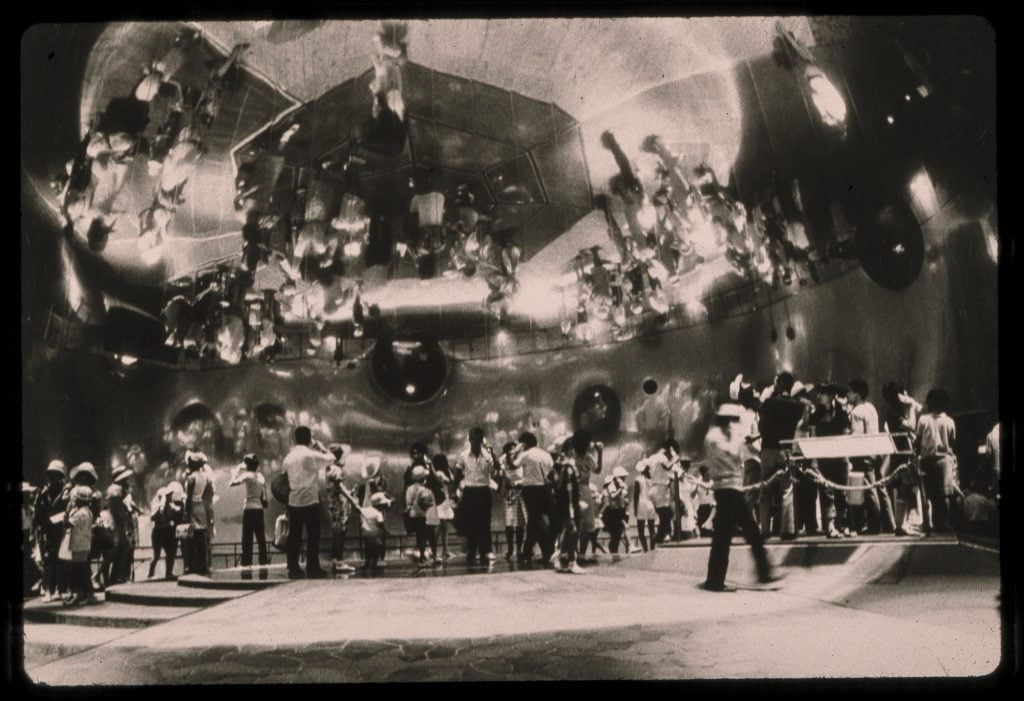
Interior of the Mirror Dome at the Pepsi-Cola Pavilion, 1970. Photo: © Fujiko Nakaya. Courtesy Experiments in Art and Technology. © J. Paul Getty Trust.
“The Pepsi Pavilion,” Perloff reflected in the show’s accompanying publication, “is emblematic and indeed a capstone of the collaboration between artists and engineers that defined [E.A.T.].”
The sheer effort that went into E.A.T.’s Pepsi Pavilion occupies the second gallery of the exhibition. Photographs, videos, and other artifacts variously spotlight the dome’s architectural design and elaborate sound system. A reproduction of a console allows visitors to recreate the pavilion’s sound-modifying aspects.
The project, alas, cost so much to operate and was so experimental in form that its corporate sponsor, Pepsi-Cola, pulled the plug after a month. E.A.T. was forced to abandon the pavilion.

Installation view of “Sensing the Future: Experiments in Art and Technology (E.A.T.)” at the Getty Research Institute. Photo: Min Chen.
But of course, it wouldn’t be the last time artists and engineers attempted such a spectacle. Today’s glut of immersive shows similarly engineer multi-sensory environments (with presumably less overhead), while the fields of art and technology are far from strangers to each other. And the once-radical proposals by E.A.T., which scaled back operations around 1975, don’t seem so unfeasible today.
Consider sound pioneer and E.A.T. member David Tudor’s Island Eye Island Ear (1970), documentation of which caps the exhibition. The environmental work proposed to transform the Swedish island of Knavelskär into an art installation with sound and reflectors, with fog by Nakaya and kites by Jackie Matisse. “It was going to be a kind of concert on the island,” Perloff explained. “They never got it off the ground.”
But they have now. The piece was most recently realized on the Norwegian island of Svinøya, as part of the 2024 Lofoten International Art Festival, following a stop on Kamome Island in Hokkaido. It’ll likely continue to be reimagined into the future.
“Sensing the Future: Experiments in Art and Technology (E.A.T.)” is on view at the Getty Research Institute, 1200 Getty Center Dr #1100, Los Angeles, California, through February 23, 2025.

